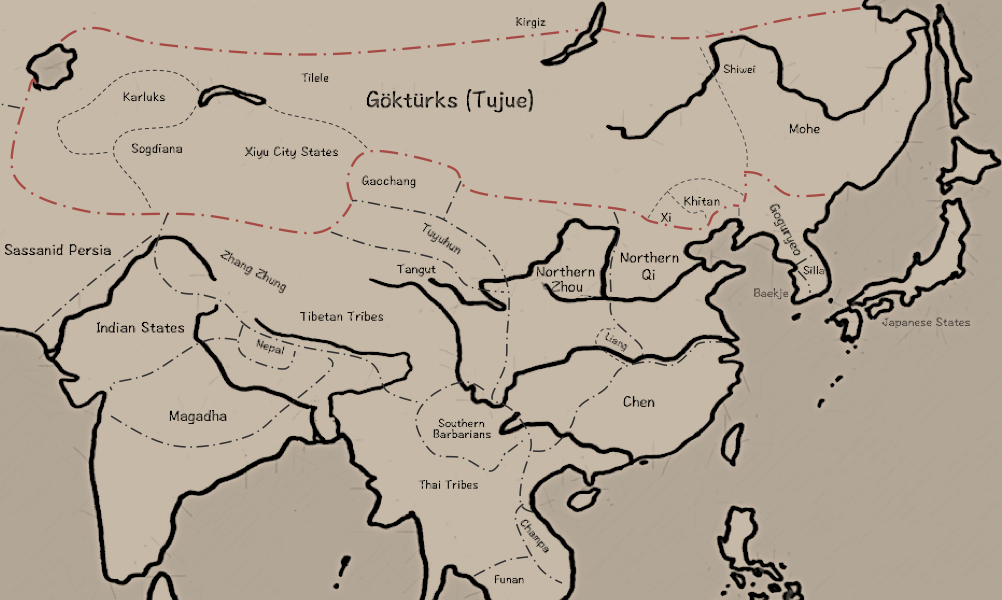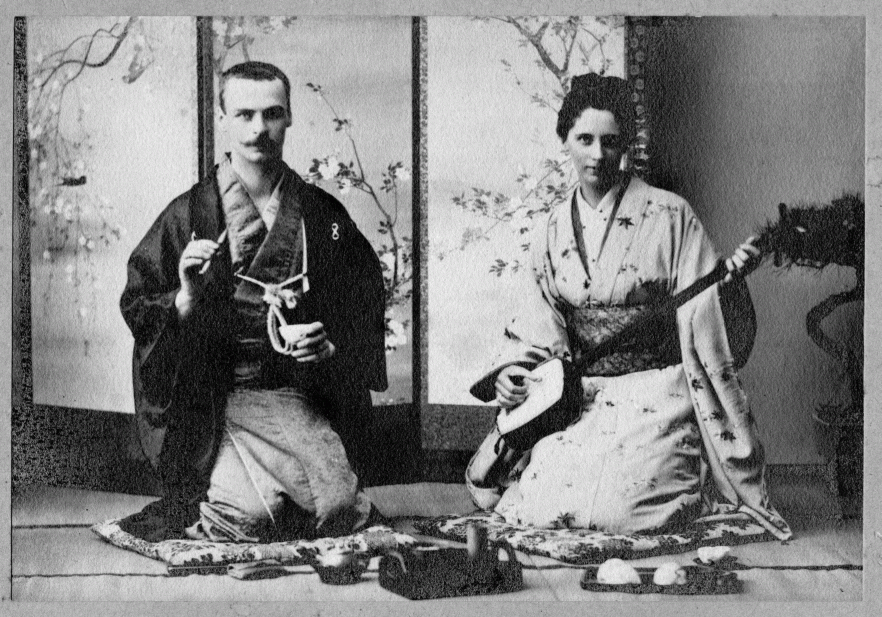|
Niri Qaghan
Niri Qaghan (; Sogdian: ''nry x’γ’n'', Ruanruan: ''nı̣rı̣ kagan'') was a ruler of the Western Turkic Khaganate. Reign According to Baumer he ruled from 579 to circa 602/03. Baumer notes that the better-documented Tardu ruled from 575 to 603. According to de La Vaissere, the unnamed Turkic ruler who was in correspondence with Emperor Maurice was Niri. Family He was the grandson of Muqan Qaghan. His Chinese wife Lady Xiang (向氏) was married to his brother Poshi Tegin (婆實特勤) after his death and submitted to the Tang during end of the Kaiyuan era. However, his exact death date remains problematic. According to Chavannes, he died in 603 in a battle during rebellion. Osawa on the other hand, states he died in 599. He was survived by his son Heshana Khagan. Legacy His memorial complex and statue was found in 2003 by Osawa Takashi in Xinjiang. He founded a Buddhist temple in Romitan Romitan ( uz, Romitan/Ромитан, russian: Ромитан) is a city ... [...More Info...] [...Related Items...] OR: [Wikipedia] [Google] [Baidu] |
Zhaosu County
Mongolküre County ( mn, ; ug, موڭغۇلكۈرە ناھىيىسى, translit=Mongghulküre; zh, s=蒙古库热县, links=no), also Zhaosu County ( zh, s=昭苏县) as the Chinese romanized name, is a county situated within the Xinjiang, Xinjiang Uyghur Autonomous Region and is under the administration of the Ili Kazakh Autonomous Prefecture, bordering Kazakhstan's Almaty Region to the west. It contains an area of . According to the 2002 census, it has a population of 150,000. Administrative divisions Town (镇) *Mongolküre Town (昭苏镇) Township (乡) *Xonuqay Township (洪纳海乡) , Uzunbulaq Township (乌尊布拉克乡) , Aqdala Township (阿克达拉乡) , Sarqobu Township (萨尔阔布乡) , Qashajar Township (喀夏加尔乡) , Qarasu Township (喀拉苏乡) Ethnic Township (民族乡) *Chaganuysun Mongol Ethnic Township (察汗乌苏蒙古族乡) , Shota Kirghiz Ethnic Township (夏特柯尔克孜族乡) , Husongtukaerxun Mongol Ethnic Township (胡松图 ... [...More Info...] [...Related Items...] OR: [Wikipedia] [Google] [Baidu] |
Muqan Qaghan
Muqan Qaghan (Old Turkic: 𐰢𐰆𐰴𐰣𐰴𐰍𐰣 Muqan qaγan, Chinese:木桿可汗/木杆可汗, Pinyin: mùgǎn kěhàn, Wade-Giles: mu-kan k'o-han or 木汗可汗, mùhàn kěhàn, mu-han k'o-han, personal name: 阿史那燕都, āshǐnà yàndōu, a-shih-na yen-to, Sogdian: ''mwx’n x’γ’n'', Ruanruan: ''Muɣan Qaɣan'') was the second son of Bumin Qaghan and the third khagan of the Göktürks who expanded their khaganate and secured the borders against the Hephthalites. Reign His accession to power was followed by finishing off remnants of Rouran. Around the new year 554, after defeat of Yujiulü Kangdi at the hands of Göktürks, the remnants of Rouran, which by that point was near its end, surrendered to Northern Qi to seek protection from Gökturks attacks. Emperor Wenxuan personally attacked Muqan Qaghan, fighting his army off and then created Yujiulü Anluochen as the new khagan of Rouran, settling the Rouran people within Northern Qi territory, at Mayi ( ... [...More Info...] [...Related Items...] OR: [Wikipedia] [Google] [Baidu] |
7th-century Turkic People
The 7th century is the period from 601 ( DCI) through 700 ( DCC) in accordance with the Julian calendar in the Common Era. The spread of Islam and the Muslim conquests began with the unification of Arabia by Muhammad starting in 622. After Muhammad's death in 632, Islam expanded beyond the Arabian Peninsula under the Rashidun Caliphate (632–661) and the Umayyad Caliphate (661–750). The Muslim conquest of Persia in the 7th century led to the downfall of the Sasanian Empire. Also conquered during the 7th century were Syria, Palestine, Armenia, Egypt, and North Africa. The Byzantine Empire suffered setbacks during the rapid expansion of the Caliphate, a mass incursion of Slavs in the Balkans which reduced its territorial limits. The decisive victory at the Siege of Constantinople in the 670s led the empire to retain Asia Minor which assured the existence of the empire. In the Iberian Peninsula, the 7th century was known as the ''Siglo de Concilios'' (century of councils) ... [...More Info...] [...Related Items...] OR: [Wikipedia] [Google] [Baidu] |
Ashina House Of The Turkic Empire
{{disambig, surname ...
Ashina may refer to: *Ashina tribe, a ruling dynasty of the Turkic Khaganate *Ashina clan (Japan),_one_of_the_Japanese_clans *Ashina_District,_Hiroshima.html" ;"title="DF 7 of 80; retrieved 2013-5-4 ..., one of the Japanese clans *Ashina District, Hiroshima">DF 7 of 80; retrieved 2013-5-4 ..., one of the Japanese clans *Ashina District, Hiroshima, a former Japanese district *Empress Ashina (551–582), empress of the Chinese/Xianbei dynasty Northern Zhou *Sei Ashina (1983–2020), Japanese actress *Main setting of ''Sekiro: Shadows Die Twice'' See also *[ sena, a mythical female wolf found in old Turkic mythology *Ashna (other) Ashna may refer to: Surname * Hesamodin Ashna, Iranian politician presidential advisor * Hossein Ashena, Iranian footballer. Given name * Ashna Zaveri, Indian actress * Ashna Roy, Indian female badminton player Places * Ashna, Khonj, a villag ... [...More Info...] [...Related Items...] OR: [Wikipedia] [Google] [Baidu] |
Inscription Of Hüis Tolgoi
The Inscription of Hüis Tolgoi (HT) is a monolingual inscription in a Mongolian language found in Bulgan Province, Mongolia in 1975 by D. Navaan. The 11-line text is written in vertical Brahmi script running right to left with horizontal marks separating words. The language of the inscription was unknown until the joint expedition of Alexander Vovin, Étienne de la Vaissière, Dieter Maue and Mehmet Ölmez to Mongolia in 2014 for closer imaging of the stele. Due to certain morphological peculiarities the language of the inscription was hypothesized to be Mongolic rather than Turkic. The language, "which can be conditionally termed as a variety of Para-Mongolic," is "much closer to the mainstream Mongolic languages, such as Middle Mongolian and modern extant Mongolic languages than to Serbi-Khitan," and is beyond reasonable doubt some form of Mongolic, close to the mainstream Mongolic language. Dieter Maue, a specialist in Sanskrit and Brahmi, deciphered the Brahmi script of th ... [...More Info...] [...Related Items...] OR: [Wikipedia] [Google] [Baidu] |
Romitan
Romitan ( uz, Romitan/Ромитан, russian: Ромитан) is a city and seat of Romitan District in Bukhara Region in Uzbekistan Uzbekistan (, ; uz, Ozbekiston, italic=yes / , ; russian: Узбекистан), officially the Republic of Uzbekistan ( uz, Ozbekiston Respublikasi, italic=yes / ; russian: Республика Узбекистан), is a doubly landlocked cou .... The town population was 9,636 people in 1989, and 14,300 in 2016. References Populated places in Bukhara Region Cities in Uzbekistan {{Uzbekistan-geo-stub ... [...More Info...] [...Related Items...] OR: [Wikipedia] [Google] [Baidu] |
Buddhist Temple
A Buddhist temple or Buddhist monastery is the place of worship for Buddhists, the followers of Buddhism. They include the structures called vihara, chaitya, stupa, wat and pagoda in different regions and languages. Temples in Buddhism represent the pure land or pure environment of a Buddha. Traditional Buddhist temples are designed to inspire inner and outer peace. Architecture Its architecture and structure varies from region to region. Usually, the temple consists not only of its buildings, but also the surrounding environment. The Buddhist temples are designed to symbolize five elements: fire, air, water, earth and wisdom. India The design of temples in India was influenced by the idea of a place of worship as a representation of the universe. For Buddhist temple complexes one tall temple is often centrally located and surrounded by smaller temples and walls. This center surrounded by oceans, lesser mountains and a huge wall. A Chaitya, Chaitya hall or Chaitya-griha ... [...More Info...] [...Related Items...] OR: [Wikipedia] [Google] [Baidu] |
Édouard Chavannes
Émmanuel-Édouard Chavannes (5 October 1865 – 29 January 1918) was a French sinologist and expert on Chinese history and religion, and is best known for his translations of major segments of Sima Qian's ''Records of the Grand Historian'', the work's first ever translation into a Western language. Chavannes was a prolific and influential scholar, and was one of the most accomplished Sinologists of the modern era notwithstanding his relatively early death at age 52 in 1918. A successor of 19th century French sinologists Jean-Pierre Abel-Rémusat and Stanislas Julien, Chavannes was largely responsible for the development of Sinology and Chinese scholarship into a respected field in the realm of French scholarship. Life and career Édouard Chavannes was born on 5 October 1865 in Lyon, France. As a youth he studied at the ''lycée'' in Lyon, where, like most students of his era, his education focused mainly on the Latin and Greek classics. Chavannes was then sent to Par ... [...More Info...] [...Related Items...] OR: [Wikipedia] [Google] [Baidu] |
Kaiyuan Era
Emperor Xuanzong of Tang (; 8 September 685 – 3 May 762), personal name Li Longji, was the seventh emperor of the Tang dynasty in China, reigning from 712 to 756 CE. His reign of 44 years was the longest during the Tang dynasty. In the early half of his reign he was a diligent and astute ruler. Ably assisted by capable chancellors like Yao Chong, Song Jing and Zhang Yue, he was credited with bringing the Tang dynasty to a pinnacle of culture and power. Emperor Xuanzong, however, because of his interest in his two beloved concubines who were involved in governmental matters ( Consort Wu and later with her death; was succeeded by Yang Guifei) and was blamed for over-trusting Li Linfu, Yang Guozhong and An Lushan during his late reign, with Tang's golden age ending in the An Lushan Rebellion. Background Li Longji was born at the Tang dynasty eastern capital Luoyang in 685, during the first reign of his father Emperor Ruizong (Li Dan) – but at that time, Emperor Ruizong's mo ... [...More Info...] [...Related Items...] OR: [Wikipedia] [Google] [Baidu] |
Tang Dynasty
The Tang dynasty (, ; zh, t= ), or Tang Empire, was an Dynasties in Chinese history, imperial dynasty of China that ruled from 618 to 907 AD, with an Zhou dynasty (690–705), interregnum between 690 and 705. It was preceded by the Sui dynasty and followed by the Five Dynasties and Ten Kingdoms period. Historians generally regard the Tang as a high point in Chinese civilization, and a Golden age (metaphor), golden age of cosmopolitan culture. Tang territory, acquired through the military campaigns of its early rulers, rivaled that of the Han dynasty. The House of Li, Lǐ family () founded the dynasty, seizing power during the decline and collapse of the Sui Empire and inaugurating a period of progress and stability in the first half of the dynasty's rule. The dynasty was formally interrupted during 690–705 when Empress Wu Zetian seized the throne, proclaiming the Zhou dynasty (690–705), Wu Zhou dynasty and becoming the only legitimate Chinese empress regnant. The devast ... [...More Info...] [...Related Items...] OR: [Wikipedia] [Google] [Baidu] |
Maurice (emperor)
Maurice ( la, Mauricius or ''Mauritius''; ; 539 – 27 November 602) was Eastern Roman emperor from 582 to 602 and the last member of the Justinian dynasty. A successful general, Maurice was chosen as heir and son-in-law by his predecessor Tiberius II. Maurice's reign was troubled by almost constant warfare. After he became emperor, he brought the war with Sasanian Persia to a victorious conclusion. The empire's eastern border in the South Caucasus was vastly expanded and, for the first time in nearly two centuries, the Romans were no longer obliged to pay the Persians thousands of pounds of gold annually for peace. Afterward, Maurice campaigned extensively in the Balkans against the Avars—pushing them back across the Danube by 599. He also conducted campaigns across the Danube, the first Roman emperor to do so in over two centuries. In the west, he established two large semi-autonomous provinces called exarchates, ruled by ''exarchs'', or viceroys of the emperor. In It ... [...More Info...] [...Related Items...] OR: [Wikipedia] [Google] [Baidu] |





.jpg)
